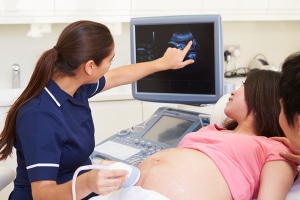Chorionic Villus Sampling (CVS)
‘Chorion’ is the medical term for placental tissue.
Chorionic Villus Sampling (CVS) is a medical procedure performed on a pregnant woman to take a small sample of cells from the placenta.
CVS is usually done with a needle inserted through the woman’s abdomen (‘transabdominal’ CVS). Less commonly, a CVS can be performed through the vagina and the cervix (‘transcervical’ CVS).
The most common reason for having a CVS is to test for Down syndrome or other genetic (or chromosome) conditions in pregnancy. A CVS can be performed earlier than an amniocentesis (from 11 weeks for CVS, compared with 15 weeks for amniocentesis).A CVS is offered if you have been identified as having an increased chance of having a baby with Down syndrome or another genetic (or chromosome) condition, usually following an ultrasound scan or blood screening test.
Sometimes a woman may have a CVS to test the baby for other conditions such as an inherited disease.
Your doctor should fully explain the reasons for offering a CVS to you and obtain your written consent before performing the procedure.
How is a CVS performed?
A CVS is a procedure performed by a specialist doctor using ultrasound assistance. You may be asked to attend with a full bladder but otherwise do not need any special preparation before the procedure. You can eat and drink normally on the day.
The doctor will check the location of your placenta and your baby’s heartbeat with ultrasound. For a transabdominal CVS, the doctor cleans the skin on your abdomen with antiseptic. Local anaesthetic is injected to numb the skin before the CVS needle is inserted.
The ultrasound is used to guide the CVS needle safely through the skin into the placenta, avoiding any contact with the baby. The needle is only inside the womb for a minute or two. Afterwards a small dressing is placed on the skin puncture site. You will remain awake during the whole procedure. You may find it helpful to bring a support person with you for the procedure.
Occasionally, the position of the placenta may make it difficult to perform a CVS. If this happens, your doctor may advise waiting a week or two until the placenta and womb are larger.
Alternatively, your doctor may recommend a transcervical (through the cervix / neck of the uterus) CVS or delaying testing until 15 to 16 weeks when an amniocentesis can be performed.
Does having a CVS hurt?
The pain from a CVS needle is similar to having a blood test from your arm, but there may be cramping, period-like pain during the procedure as well. For the vast majority of women, local anaesthetic is all that is required for the procedure.

What are the risks of a CVS?
There is a small risk of miscarriage during any pregnancy and having a CVS may increase the overall risk. The chance of miscarriage after a CVS is commonly given as 1 in 100 (1%). The amount of tissue removed at CVS is very small (15-30mg) and should not affect placental function.
Are there any tests that need to be done before a CVS?
How far your pregnancy has progressed (your gestational age) should be confirmed before your CVS is booked. It is not recommended to have a CVS before 11 weeks gestation, as the risk of complications is higher.
Your blood group should also be checked before having a CVS. If you are a ‘negative’ blood group (Rhesus negative), then you will need to have an injection of anti-D immunglobulin after the procedure.
Your hepatitis B and HIV status (and hepatitis C, if performed) should also be reviewed. All pregnant women are tested for these infections in early pregnancy, so the results should be readily available. You should discuss your individual circumstances with your doctor if you are positive for any of these infections.

How should I look after myself after the procedure?
You should avoid any heavy physical activity after your procedure, but you do not need to rest in bed. You can take the dressing off your abdomen that evening. You should feel physically back to normal by the next day and you can resume your normal activities after 1-2 days if you feel well. Your doctor should discuss what to expect following a CVS. Some mild period-like pain is common on the first night and it is safe to use a regular dose of paracetamol for pain relief.
When to get medical advice
Your doctor should tell you whom to contact if you are worried. If you have any vaginal bleeding, severe abdominal pain, high fever or unusual fluid loss from the vagina, you should go to your local hospital’s Emergency Department for assessment. In general, if everything has been fine for the first week or two after the CVS, it is very unlikely for complications to occur after this.
How do I get the results of the CVS?
Please check with your doctor about how you are going to receive your results. You should be given a contact number to call in case you have any concerns.
DISCLAIMER: This information is intended to be used as a guide of general nature, having regard to general circumstances. The information presented should not be relied on as a substitute for medical advice, independent judgement or proper assessment by a doctor, with consideration of the particular circumstances of each case and individual needs. This information reflects information available at the time of its preparation, but its currency should be determined having regard to other available information. RANZCOG disclaims all liability to users of the information provided.